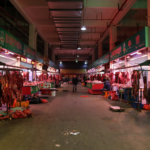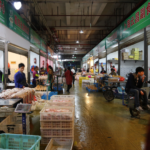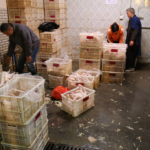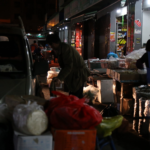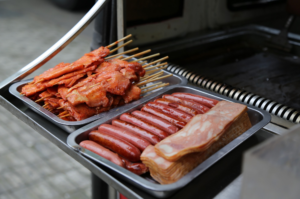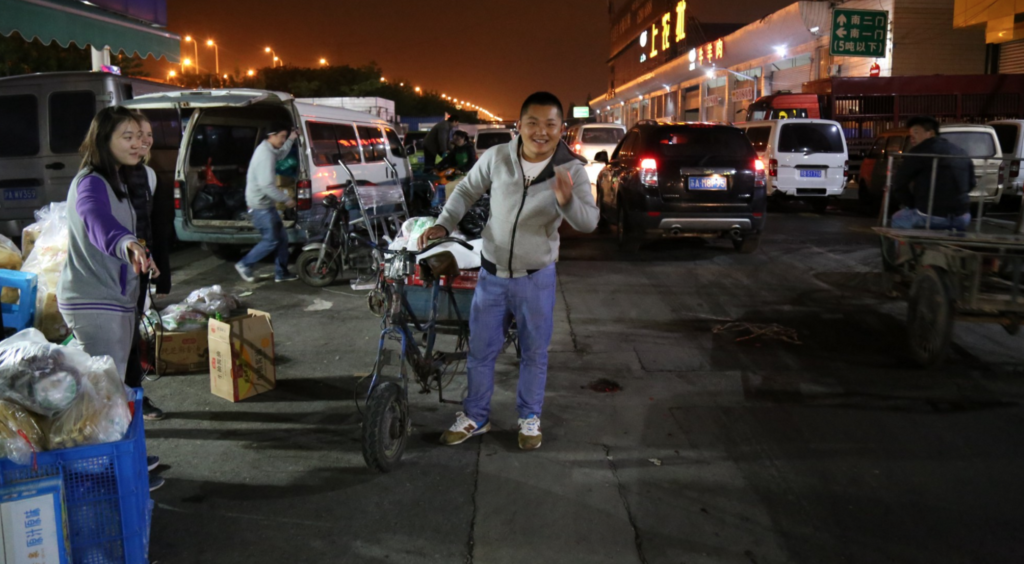
Li Fei, a diligent and sweet young man from Anhui province moved to Shanghai over seven years ago to join his father and family. After a bumpy road entering the informal street-food industry he managed to pull a few strings and cop two shiny red legal food trucks from a formal and legal street food company, both of which are now on Century Avenue. He has found a home within this economy selling his hometown Huai Nan Niu Rou Tang 淮南牛肉汤 on one of his trucks and processed breakfast food from the cart company on the other.
After many visits to his delicious Noodle and Beef Soup cart for lunch,we started to wonder what kind of life Li Fei led and we did a little preliminary research project exploring some issues he discussed with us. He once told us it takes him several hours to prepare the food he sells, especially his soup and he mentioned his daily trips to Shanghai Nong Ye Wholesale Market (上海农业中心批发市场) to get the fresh cucumber, tofu, beef and other ingredients needed for his dishes everyday. Curiously and hyper excited, we asked him if we could follow him on his little market journey on a Sunday morning and he eagerly agreed- though thought it quite a bizarre request. We met him at 2.30am in front of the market as the trucks and vendors were setting up, getting ready for their business day to commence.
Shanghai Wholesale Market 上海农业中心批发市场
The 上海农业批发市场 was built over 15 years ago and is open 24/7, with produce that arrives fresh every night and dawn from every corner of China. Once it opened in 1997, you could buy a stand and sell your products but now one can only rent the space rather than buy it.
Since we arrived half an hour early, we decided to perhaps interview some workers at the gate and in a small room at the entrance about this market — just with simple questions in mind about when the market opened and what types of food are sold here. However, it was dramatically difficult to find someone who would speak to us. When we did, a man at the info center said he would call the person who is assigned the job to speak on the behalf of the market (a spokesperson more or less) who deals with these types of questions. We agreed to meet with him but were shocked at the fact that once we were introduced, apart from the fact he whispered everything because his tone of voice was really low, he said his Mandarin was not good enough and that he could only speak Shanghainese. We took the fact that they deemed this man the spokesperson of the market as a sign that there was a lot that they didn’t want us to know. All of this set a quite mysterious and dramatic overtone to what ended up being a fantastic market experience. We found it quite bizarre that the people who are the face of the market, who work at the entrance collecting fees for trucks coming in and who work at the info center, were the least helpful or keen in the market.
Scattered in some corners of the huge space this market occupies on Middle Ring Road and Hu Nan Road (沪南路 2000), are some offices deemed as “Food Sanitation/Quarantine Offices” which theoretically regularly check on the quality and sanitation of the products being sold here. However, when we arrived they were all pretty much closed and we didn’t manage to get a hold of anyone who could speak to us from those entities on the issue of sanitation in this space. Throughout our interview and experience with Li Fei in the market, he mentioned that we shouldn’t really film all the spaces, especially some of the vendors’ food because there are some sanitary infractions and issues going on which some vendors might be concerned with if they were to find out it was being filmed, so we dully accepted.
Vendors in the Market
The atmosphere of the market was quite special, with people buying and selling bulks of hundred of fresh chickens and loading whole skinned dead pigs directly into quite rugged and old trunks of cars. Some vendors were very light hearted and quite interested in speaking to us about their routines and products. Some of these vendors have been selling there for years and it was quite interesting to see the relationship between Li Fei, a customer for them and generally a street-food vendor, and the places where he buys his products and ingredients. Li Fei has a very dynamic relationship with these vendors as we could see from the automatic reflex they all had to smile and predict the things Li Fei was about to buy when they saw him approaching (and also… di$count$$). It was also a bonus that we were accompanied by him because it meant that these vendors were openly speaking to us since they trusted LiFei, who has been coming to them daily for many years. Here we put together some of the things the vendors were keen to tell us and a little about their job and products.

Formal Economy of Street-Food Vending
After seeing how Li Fei gathered his products for his day ahead- I think it’s worth mentioning that he spent all together a striking 2,000 kuai that morning alone, which weekly might add up to spending 5,500–6,000RMB on ingredients from this market- we went on to see how he divides his time between the two carts and the two types of products he sells.
After several years being an unofficial street vendor, he started to feel uneasy about the fact that many cheng guan were regularly coming to shutdown vendors like him, in an attempt at clearing up the streets of Pudong. This was happening also because the restaurants in the area were complaining about the illegal street-food vending, like Li Fei’s, which was ruining their business. Due to how often the police, cheng guan and xie guan kept coming to check up on them, he decided to try and enter the formalized version of the economy in which he had been working in for so long.
*side note: cheng guan (城管) are local law enforcement who are in charge of making sure the streets are clean and not being used for commercial use by unlicensed food-cart owners. xieguan (协管) on the other hand are not working for the government and are simply helpers to the chengguan*
Over a year ago, he approached one of his friends who worked for the food company “爱心帮帮车” (which swiftly translates as “Love Help Car” in English) which is attempting to formalize the street-food economy in Shanghai by assigning carts in designated areas to certain vendors who are deemed suitable. The company gives you a cart and assumes you buy their food products to sell in their/your cart. Once a month they collect a fee from the vendors (ranging from 1,000-over 5,000RMB depending on the location and size of the cart) but that seems to be about the only contact you have with the company. Li Fei has told us that this lifestyle and job working from a formal cart is much more calm and stable since he no longer needs to worry about being shutdown, having his things stolen by the cheng guan or being beaten up by the xie guan.
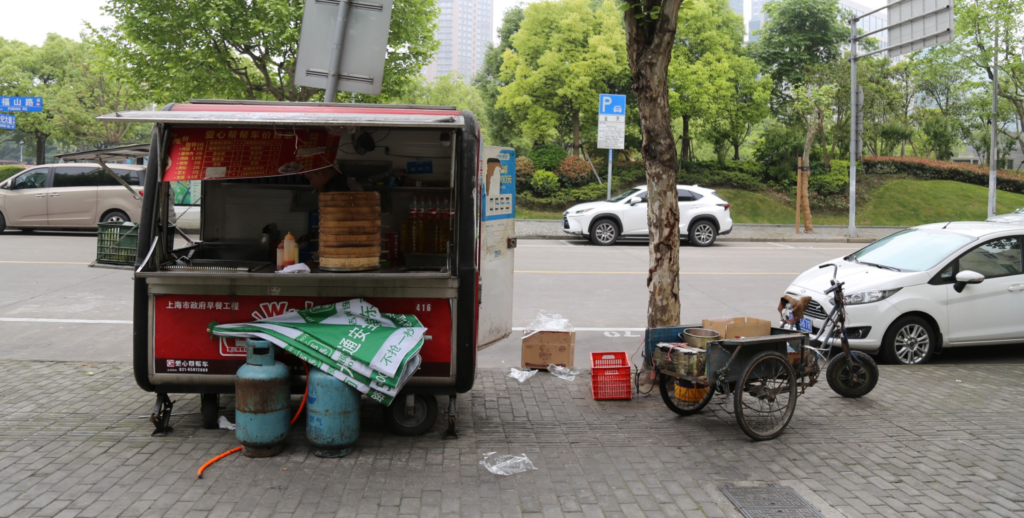
Li Fei’s Food Carts
Hehas two carts in Pudong, both bordering Century Avenue and he spends his day between the two. Cart #1 is situated in front of Xiang Cheng Lu 17 and he is there daily (except some weekends when it’s raining) from 12–13.45pm and from 4.30–6pm. Cart #2 is situated close to the Century Avenue Metro Exit 7 and it’s on Wei Fang Lu and Century Avenue, open from 6am-9pm.
In this cart #1 he sells his delicious Huai Nan Niu Rou Tang (淮南牛肉汤)in winter and Shann Xi Liang Pi (陝西涼皮) in summer, with the ingredients he buys at the Shanghai Nong Ye Wholesale Market (上海农业批发市场) daily. Because this cart’s business relies on the emplyees and workers from banks and other offices near by, whose employees buy his delicious creations at lunch and dinner, he doesn’t open it on weekends or public holidays. His other cart, #2, is one in which he sells the company’s food products (chicken skewers, baozi..) and he has someone covering for him (his mother actually) whilst he is in cart #1 selling his home-town’s food.
Li Fei has been working for his licensed food company since it opened in Pudong over a year ago. The name of the company is on all of the food carts (“爱心帮帮车”) and most of the cart owners near Century Avenue all know each other- since Li Fei once told us many of them come from the same province as he.
It is worth mentioning that every vendor from “爱心帮帮车” is supposed to buy food products from the company itself to sell in the company’s carts. However, these products are expensive for the type of quality they are, so many vendors like Li Fei sneakily sell their own products (such as his Huai Nan Niu Rou Tang 淮南牛肉汤). This is a great dish from his province in Anhui and it takes a lot of preparation (2h for the soup early in the morning and a lot of fresh ingredients!). His cart is super packed during lunch time as workers from banks and nearby offices heard to his cart/nest and he sells out daily during the hour and a half he’s there for. He sells one of these delicious bowls from 12RMB (14RMB if you want to add an egg) and the costumers are all regulars. Just like the vendors at the wholesale market could predict what Li Fei was coming to buy from them daily, as soon as Li Fei sees someone approaching his cart, he starts putting their regular choice of noodles to boil before they even have to tell him. (Choice of noodles range from sweetpotato to rice and you can select the herbal toppings you want)
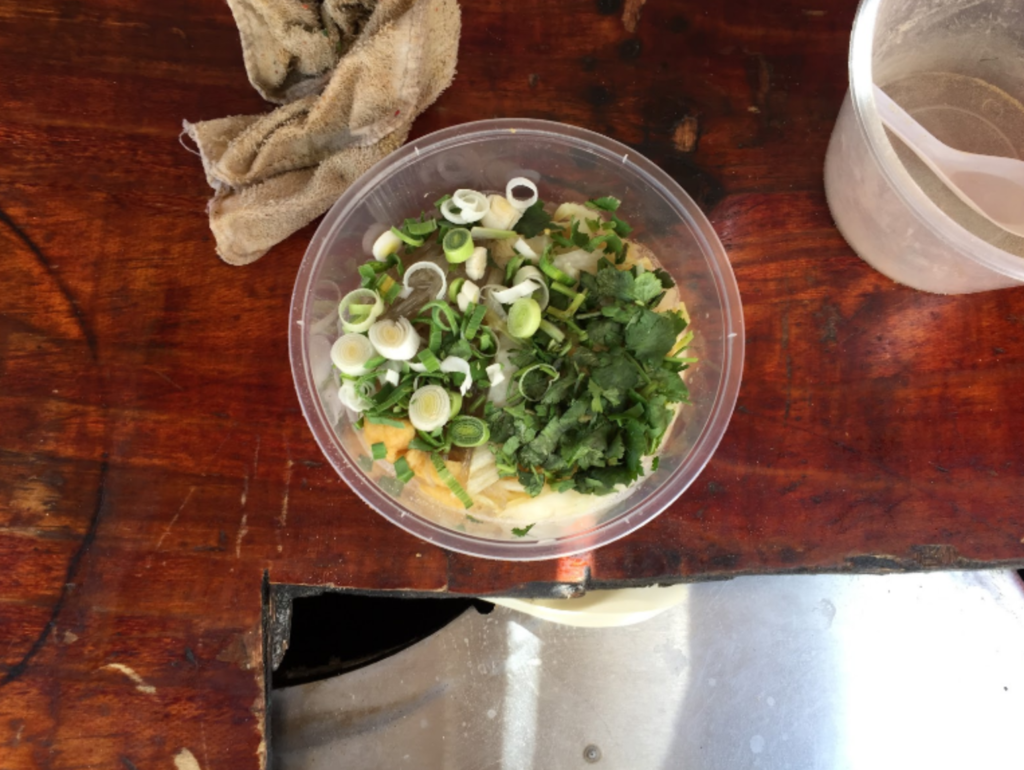
Li Fei as the voice of a street vendor
Wefollowed him around both of his carts and asked him a couple of questions about what he thinks this legislation and attempt at formalizing this classically informal, street-food economy really means. We wanted to find out what food meant for these vendors: what role does food play in Chinese culture? Do they think this formalisation will potentially take over and there will no longer be those chuanr ladies outside on Yong Fu Lu selling over MSGed (questionably unsanitary) skewers at unreasonable hours after a night out? Is food important?
Here we have Li Fei, telling us what he thinks about the issue…
Being a street vendor is tough, specially if you’re not part of the legalized economy like Li Fei was previously. There are constant risks and pitfalls which make life as a migrant very tricky in such a big and bustling international city like Shanghai. Food is an integral part of our lives and most of us become numb to the process of making it. There is a lot that goes on behind what we see when we order a simple soup in the street and we are very grateful for Li Fei’s trust and enthusiasm to let us film him and follow him on one of his working days. He’s a very interesting person to work with since he was constantly shy but open about what he wanted to tell us. There was a sense of pride when he introduced us to his vendors at the market so it was very admirable of him to let us create our whole project around him in a way.
Here is a fun little clip we have put together of three of our favourite street-food vendors, who sell food in their “爱心帮帮车” carts on Century Avenue, like Li Fei.
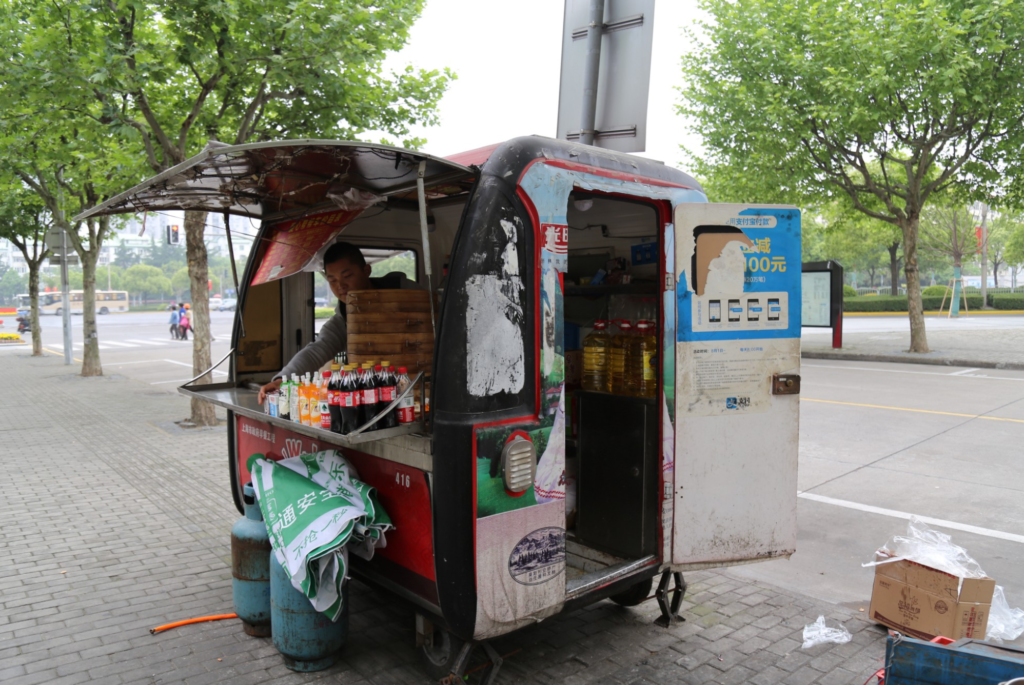
by Anita Bonomi (柏悅), 尹懿 (Alice), Arianna Rodriguez (芮涵)



